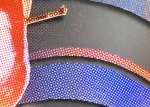zipperhead
Member
I need to print a white ink gradient under a 4/C process screen on silver substrate. Any suggestions on a screen angle for the white?
We are a flexo shop so our current cmyk angles are:
C=67.5
M=7.5
Y=22.5
K=37.5
I know that 52.5 won't work (it creates a pattern)
Any input would be appreciated
Thanks
We are a flexo shop so our current cmyk angles are:
C=67.5
M=7.5
Y=22.5
K=37.5
I know that 52.5 won't work (it creates a pattern)
Any input would be appreciated
Thanks











